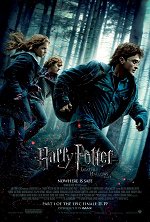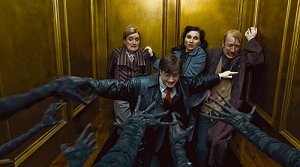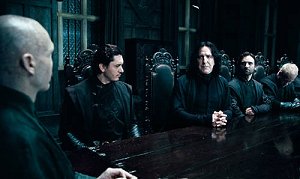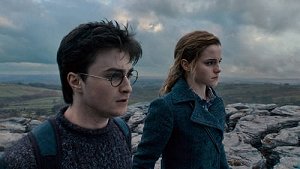 |
|
At The Picture Show
|
November 2010
The beginning of the end
From brilliant to middling, 'Deathly Hallows: Part I' runs the gamut

Harry Potter and the Deathly Hallows: Part I
Warner Bros. Pictures
Director: David Yates
Screenplay: Steve Kloves
Starring: Daniel Radcliffe, Emma Watson, Rupert Grint, Ralph Fiennes, Jason Isaacs, Helena
Bonham-Carter, Bill Nighy and Rhys Ifans
Rated PG-13 / 2 hours, 26 minutes
Opened November 19, 2010


 (out of four)
(out of four)
It speaks volumes about Harry Potter and the Deathly Hallows: Part I that most of its best scenes
are of the "in-between" variety - not plot points or action sequences, but quiet moments that take place
between characters, or transitional scenes leading up to major events. An impromptu dance number
between close friends. A parable brought to life by a stunning animated sequence. A sudden
suspenseful moment as a character in hiding nearly gets discovered.
For a film as lumpy and wildly uneven as Deathly Hallows, it remains remarkably effective - primarily
on the strength of such moments. There's so much setup in this installment - presumably for an action-packed finale next summer - that its tone flies all over the place as director David Yates tries to get all
his ducks in a row.
 The film's strongest sequences rank among the best of the entire series.
But there's a distinct disconnect between those scenes and the rest of the movie. Admittedly, Yates has
a difficult job on his hands with this climactic two-parter, tasked with piecing together five-plus hours'
worth of material into two different segments that, ideally, should stand up independent of the other.
The film's strongest sequences rank among the best of the entire series.
But there's a distinct disconnect between those scenes and the rest of the movie. Admittedly, Yates has
a difficult job on his hands with this climactic two-parter, tasked with piecing together five-plus hours'
worth of material into two different segments that, ideally, should stand up independent of the other.
In the case of Part I, it doesn't always work. There's too much of a sense of deliberate orchestration -
let's make sure we get these characters over here and this character there, let's get this plot detail into
place, etc, etc.
The extent of pure setup is often so relentless that the film doesn't seem to have quite enough time to
handle it all. Scenes that, in Yates' previous two films, would have been turned into major setpieces,
here are handled like plot requirements. I'm thinking particularly about a scene in which Harry, Ron and
Hermione find themselves captured by an old foe. It's a decent enough sequence, but it gets resolved
practically just as it's begun.
But what Deathly Hallows lacks in consistency it makes up for in presentation. What Yates seems to
understand as well as any Harry Potter director is the world in which this series exist - a world that,
over the past three films, he has helped create and define. In last year's Half-Blood Prince, he
established what amounted to a terrorist state, with dark forces hanging over everything and everyone,
Muggle and Wizard alike.
 In this film, he takes it a step further. With Lord Voldemort's (Ralph
Fiennes) minions having infiltrated nearly every level of society - most notably, the Ministry of Magic
and Hogwarts - normalcy has given way to a sort of fascism. In a triumph of art direction, we see
Nazi-inspired propaganda catching hold. In both visual cues and terminology, Yates and writer Steve
Kloves seem to have the American Red Scare of the late 1940s and '50s in mind as well - and,
deliberate or not, I was reminded also of Michael Radford's adaptation of Orwell's 1984.
In this film, he takes it a step further. With Lord Voldemort's (Ralph
Fiennes) minions having infiltrated nearly every level of society - most notably, the Ministry of Magic
and Hogwarts - normalcy has given way to a sort of fascism. In a triumph of art direction, we see
Nazi-inspired propaganda catching hold. In both visual cues and terminology, Yates and writer Steve
Kloves seem to have the American Red Scare of the late 1940s and '50s in mind as well - and,
deliberate or not, I was reminded also of Michael Radford's adaptation of Orwell's 1984.
One unique element of Deathly Hallows is that, for the first time, Hogwarts doesn't play much of a
role. Harry, Ron and Hermione's collective attention is on finding and destroying the remaining
Horcruxes as they journey through an abandoned countryside, an imposing forest and beyond. This
storyline has a distinctly postapocalyptic feel - the emptiness, the solitude, the wandering - which
makes for a nice parallel to the feeling of impending apocalyptic doom that has pervaded the last few
films.
Yates' ability to construct an atmosphere and mood to his adaptations has been his most impressive
feat. Rather than going through the motions - which he surely could have gotten away with (I mean,
come on, the brand sells itself; even Chris Columbus' lackluster efforts were smash hits) - he has dug
underneath the surface to get to what's most important, and built a distinctive aesthetic around that.
 Consider the way he contrasted the heightened emotional/hormonal
state of the teenage Hogwarts clan with the spectre of the end of the world in Half-Blood Prince. Or
the way he has grounded the series with a certain sense of realism, making its magical elements feel all
the more foreboding.
Consider the way he contrasted the heightened emotional/hormonal
state of the teenage Hogwarts clan with the spectre of the end of the world in Half-Blood Prince. Or
the way he has grounded the series with a certain sense of realism, making its magical elements feel all
the more foreboding.
Deathly Hallows: Part I may not be the best of his Harry Potter efforts, but that probably has more
to do with the scope of the final installment itself than anything else. And if the strongest moments of this
film are any indication, Yates still has as clear a vision as he ever has, and I expect he'll fully follow
through.
Continued Below Advertisement
Read more by Chris Bellamy